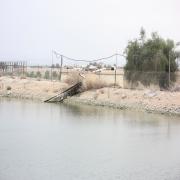Online database based on machine learning to predict the toxicity of pharmaceuticals and Transformation products (TPs) after AOPs
In the past decades, various treatments based on AOP, such as ozonation, peroxonation, and photocatalysis, have been developed to treat the persistent recalcitrant compounds (PrCs) in wastewater. In the initial stages, the disappearance of the parent compound was the priority, but later researchers understood the significance of the analysis of transformed products. Uncertainty of the TPs formed after the AOP treatment process poses a barrier in understanding the efficiency of the process. In some cases, such as 17-β Ethyleneestradiol, diuron, erythromycin doxycycline on reacting with ROS resulted in a proportional loss of biological activity. TPs of Triclosan, ranitidine after oxidative treatment are more toxic than the parent compounds. TPs of very few PrCs were investigated in the whole universe of Compounds. High-resolution LC-MS and GC-MS techniques in concomitant with data processing tools have been used to identify the TPs of several micropollutants. However, the selection of PrCs is random and very limited compared to the whole matrix of PrCs in the environment, and the number is increasing by the day. There is a severe gap in connecting the TPs and their toxicity which is essential to understand the efficiency of the wastewater treatment process. However, it is highly impractical and impossible to analyze all the existing PrCs.
Nevertheless, this study is essential as many countries adapt AOP-based wastewater treatment. Instead of selecting random PrCs, we focus on active functional moiety on the molecules responsible for toxicity. If we understand the fate of this moiety and toxicity of TPs prior to and after various treatments, the same pathway can be transferrable to all the molecules with similar moiety. We aim to create an online database connecting TPs' mechanistic pathways and toxicity after various AOPs for several active functional moieties. The first step is to select several active functional moieties in molecules responsible for toxicity which can be derived by pharmacokinetics and pharmacodynamics of individual drugs. Analytical tools such as GC-MS, LC-MS, and NMR will be utilized to understand the fate and mechanistic pathways for the degradation of PrCs. Toxicity studies will be performed for the samples before and after treatment to understand the efficiency of the process. For example, in our laboratory, we have applied filtration, biodegradation, UV photolysis, homogenous and heterogeneous ozonation to cyclophosphamide in which mustard structure is active moiety and created a database about the fate of TPs after each process. This database can be adapted to other compounds with a mustard structure such as chlorambucil, melphalan, mechlorethamine, isofomide, melflufen, Bendamustine, Estramustine, Uramutine. After collecting the data, an artificial logarithm model will be created, as shown in the Figure, which can provide the TPs and their toxicity after each treatment. We know that this study is exhaustive ad requires a lot of lab, manual, analytical, and software programming. However, this is essential as more and more countries adopt AOP-based treatments as secondary (or) tertiary treatment processes. Several case studies conducted in France, Italy, Germany proved that more information on the fate of PrCs after treatment is essential where wastewater reclamation is one of the significant sources of water. The AI database integrating mechanistic pathways of TPs and the toxicity of PrCs is highly beneficial to the scientific community in developing novel AOP technologies to treat PrCs and understand the efficiency of the developed process.





